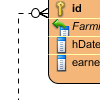Reusing ERD Entity in Business Process Diagram
With Logizian, you are allowed to re-use ERD entity in business process diagram. In this page, you will learn how to re-use entity in business process diagram by dragging and dropping.
With Logizian, you are allowed to re-use ERD entity in business process diagram. In this page, you will learn how to re-use entity in business process diagram by dragging and dropping.
When you reverse database, you will find all existing entities are overwritten in the project. This article is going to teach you how to solve this problem.
In helping you organize your modeling project, use cases can act as generic containers for all software development artifacts. Development teams can group and locate design artifacts by navigating use cases.
In this tutorial we are going to show you how to create a new data model (i.e. entity relationship diagram) and associate that with a use case. And in future, you can easily identify existing associations as such by use cases and conveniently, be taken to the related diagrams right on the spot in just a few clicks.
 The reverse database tool of VP-UML provides a handy approach to instantly convert a relational database into an ERD, to aid in the studying of database structure, entities properties and their inter-relationships.
The reverse database tool of VP-UML provides a handy approach to instantly convert a relational database into an ERD, to aid in the studying of database structure, entities properties and their inter-relationships.
Being able to study a database with an ERD is great because ERD is so easy to read and understand. However, the relationships among entities may increase the complexity of diagram when there are many entities and are highly coupled. If you just want to focus on seeing the database tables and their columns, but not pretty much interested in their inter-relationship, you can optionally form an ERD database diagram with solely entities, without including their relationships. In this article, you will see how to form an ERD from a MS SQL database, with just entities showing in the diagram. You will also learn how to optionally show the relationships.
 Visual Paradigm for UML (VP-UML) comes with an ERD database designer where database developers can model physical database with Entity Relationship Diagram. The database designer supports popular database constructs like database table (called Entity in VP-UML), View, Sequence, Stored Procedure, Trigger, etc, supporting the need of database modeling for any kind of database management systems.
Visual Paradigm for UML (VP-UML) comes with an ERD database designer where database developers can model physical database with Entity Relationship Diagram. The database designer supports popular database constructs like database table (called Entity in VP-UML), View, Sequence, Stored Procedure, Trigger, etc, supporting the need of database modeling for any kind of database management systems.
